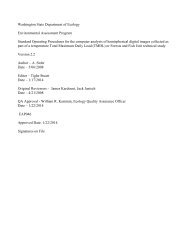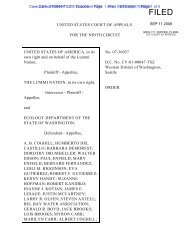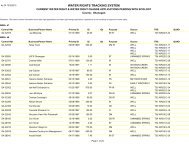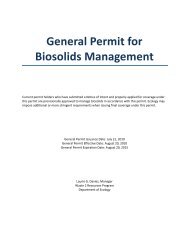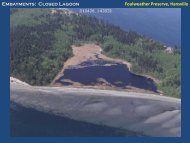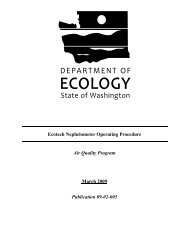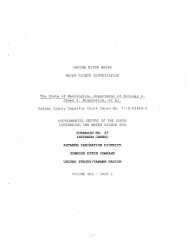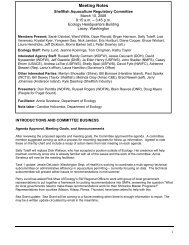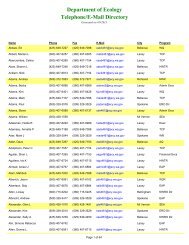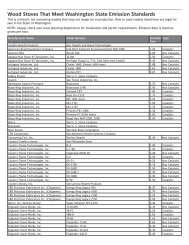WRIA 62 WMP 032305 - Washington State Department of Ecology
WRIA 62 WMP 032305 - Washington State Department of Ecology
WRIA 62 WMP 032305 - Washington State Department of Ecology
You also want an ePaper? Increase the reach of your titles
YUMPU automatically turns print PDFs into web optimized ePapers that Google loves.
March, 2005 -61- 023-1289-003.3040<br />
4.2.4 WQUAL-3b Background and Rationale<br />
Problem <strong>State</strong>ment: There is a need to participate in the TMDL processes and provide input<br />
on TMDLs for the mainstem Pend Oreille River.<br />
The Clean Water Act requires <strong>State</strong>s and Tribes with water quality jurisdiction to develop a list <strong>of</strong><br />
waterbodies not meeting water quality standards. Development <strong>of</strong> Total Maximum Daily Loads<br />
(TMDLs) is the process by which <strong>State</strong>s and Tribes attempt to achieve water quality standards.<br />
<strong>Washington</strong> <strong>State</strong> has jurisdiction over waterbodies within <strong>WRIA</strong> <strong>62</strong>, with the exception <strong>of</strong> waters<br />
within the exterior boundaries <strong>of</strong> the Kalispel Indian Reservation. The Kalispel Tribe has jurisdiction<br />
over waterbodies on Kalispel Indian Reservation lands. Idaho <strong>State</strong> has jurisdiction over waterbodies<br />
within Idaho. The role <strong>of</strong> the Environmental Protection Agency (EPA) is to review and approve<br />
TMDLs and ensure that the TMDLs will work towards attaining applicable water quality standards<br />
(i.e. <strong>State</strong> and Tribal water quality standards).<br />
Information on the <strong>WRIA</strong> <strong>62</strong> 303(d) listings and current TMDL activities are included in the Phase II,<br />
Level 2 report (Golder, 2005). Development <strong>of</strong> the Pend Oreille River TMDLs will be completed by<br />
the entities with water quality jurisdiction (i.e., <strong>Ecology</strong> in <strong>Washington</strong>, the Idaho <strong>Department</strong> <strong>of</strong><br />
Environmental Quality in Idaho and the Kalispel Tribe on reservation lands, with review and approval<br />
by EPA).<br />
<strong>Ecology</strong> is in the process <strong>of</strong> developing Total Dissolved Gas (TDG) and temperature TMDLs for the<br />
mainstem <strong>of</strong> the Pend Oreille River (Figure 4-6). Details are available in <strong>Ecology</strong>’s Quality<br />
Assurance Project Plans (QAPPs) for the Temperature and TDG Pend Oreille River Total Daily<br />
Maximum Load Technical Studies (<strong>Ecology</strong>, 2004b; <strong>Ecology</strong> 2004c). The QAPPs and information<br />
on TMDL timelines are available on <strong>Ecology</strong>’s web site<br />
(http://www.ecy.wa.gov/programs/wq/tmdl/watershed/tmdl_info-ero.html). <strong>Ecology</strong> is considering<br />
contracting with a specialist to review, expand and re-run an existing CE-QUAL-W2 temperature<br />
model for the Pend Oreille River from the Idaho state line to Box Canyon Dam, and publish this<br />
analysis in a Phase 1 report. Seattle City Light is planning to develop a CE-QUAL-W2 model for the<br />
Boundary Dam reservoir, with technical support from <strong>Ecology</strong>. The final temperature TMDL will be<br />
developed when the Idaho, Box Canyon, and Boundary models can be evaluated together. It is also<br />
<strong>Ecology</strong>’s intent to coordinate with the Idaho <strong>Department</strong> <strong>of</strong> Environmental Quality to take the output<br />
from a planned CE-QUAL-W2 temperature model <strong>of</strong> Lake Pend Oreille and the Pend Oreille River in<br />
Idaho as input to the <strong>Washington</strong> model at the state line.<br />
The following TMDLs are planned by the Idaho <strong>Department</strong> <strong>of</strong> Environmental Quality (IDEQ) in the<br />
Priest River Basin in Idaho (Table 4-6 and Figure 4-6):<br />
• Sediment, temperature and total dissolved gas for the Pend Oreille River (from Lake<br />
Pend Oreille to the <strong>Washington</strong> – Idaho border).<br />
The total dissolved gas (TDG) issues for the Clark Fork - Pend Oreille system in Idaho are primarily<br />
being addressed, at the current time, through implementation <strong>of</strong> the Gas Supersaturation Control<br />
Program for the Clark Fork Project (Avista 2004). This TDG program focuses on operations <strong>of</strong> the<br />
Cabinet Gorge Hydroelectric Development, eight miles upstream <strong>of</strong> Pend Oreille Lake. In 2005,<br />
Idaho DEQ will initiate a sub-basin assessment and TMDL effort for the Pend Oreille River. TDG<br />
issues will be examined as they pertain to the Albeni Falls Hydroelectric Project and river conditions<br />
between Albeni Falls and the Idaho - <strong>Washington</strong> state line.<br />
<strong>WRIA</strong> <strong>62</strong> <strong>WMP</strong> <strong>032305</strong>



